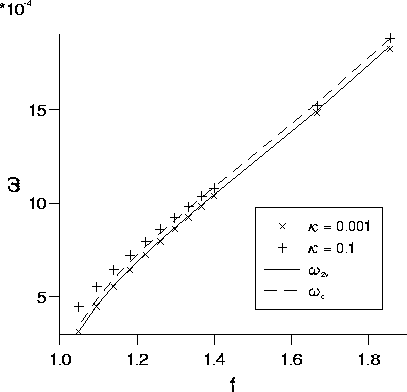A number of the simulations described above were repeated with the
interfacial energy ![]() set to 0.1. This gives a much wider interface
region in which the order parameter
set to 0.1. This gives a much wider interface
region in which the order parameter ![]() varies smoothly
indicating that there is a mixture of both fluids in the interface region
which is about 10 lattice units wide. The damping parameters found
for the waves when
varies smoothly
indicating that there is a mixture of both fluids in the interface region
which is about 10 lattice units wide. The damping parameters found
for the waves when ![]() were found to vary negligibly
from the results for a sharp interface.
A significant change was found in the
wave frequency which noticeably increased when the interface was
widened. This is shown in figures 7-29 and 7-30
were found to vary negligibly
from the results for a sharp interface.
A significant change was found in the
wave frequency which noticeably increased when the interface was
widened. This is shown in figures 7-29 and 7-30

Figure 7-29: The frequency ![]() as a function of f for
as a function of f for ![]() and
and
![]() when
when ![]() and
and ![]() . Also shown
are the theoretical frequencies
. Also shown
are the theoretical frequencies ![]() and
and ![]() for a
viscous two-layer model
and an inviscid model with a continuous density change over an
interface with width l = 10.
for a
viscous two-layer model
and an inviscid model with a continuous density change over an
interface with width l = 10.

Figure 7-30: The frequency ![]() as a function of f for
as a function of f for ![]() and
and
![]() when
when ![]() and
and ![]() . Also shown
are the theoretical frequencies
. Also shown
are the theoretical frequencies ![]() and
and ![]() for a
viscous two-layer model
and an inviscid model with a continuous density change over an
interface with width l = 10.
for a
viscous two-layer model
and an inviscid model with a continuous density change over an
interface with width l = 10.
where the solid lines and the ![]() marks are the theoretical
and experimental values which were displayed in figure 7-19. The
+ marks represent the simulation results when
marks are the theoretical
and experimental values which were displayed in figure 7-19. The
+ marks represent the simulation results when ![]() and the
dashed lines are the frequency calculated from the Sturm-Liouville
equation for an
interface width l = 10. It should be noted here that the solution
of the Sturm-Liouville
equation is only applicable to an inviscid fluid and so a
close agreement between the results and the dotted line was not expected.
In the two-layer problem the viscous frequency was seen to be modified only
slightly from its inviscid value so in this similar problem it can be expected
that the inviscid theory should at least give a rough estimate of the
frequency in a viscous fluid. These results show that the wave frequency is
sensitive to the size of the interface. When
and the
dashed lines are the frequency calculated from the Sturm-Liouville
equation for an
interface width l = 10. It should be noted here that the solution
of the Sturm-Liouville
equation is only applicable to an inviscid fluid and so a
close agreement between the results and the dotted line was not expected.
In the two-layer problem the viscous frequency was seen to be modified only
slightly from its inviscid value so in this similar problem it can be expected
that the inviscid theory should at least give a rough estimate of the
frequency in a viscous fluid. These results show that the wave frequency is
sensitive to the size of the interface. When ![]() and the
interface is no larger than 1 lu the results agree well with the
viscous two-layer theory. When the interface has a larger width,
10 lu, there is a significant change in the frequency even when the interface
is only 4% of the wavelength and 9% of depth of each fluid.
and the
interface is no larger than 1 lu the results agree well with the
viscous two-layer theory. When the interface has a larger width,
10 lu, there is a significant change in the frequency even when the interface
is only 4% of the wavelength and 9% of depth of each fluid.